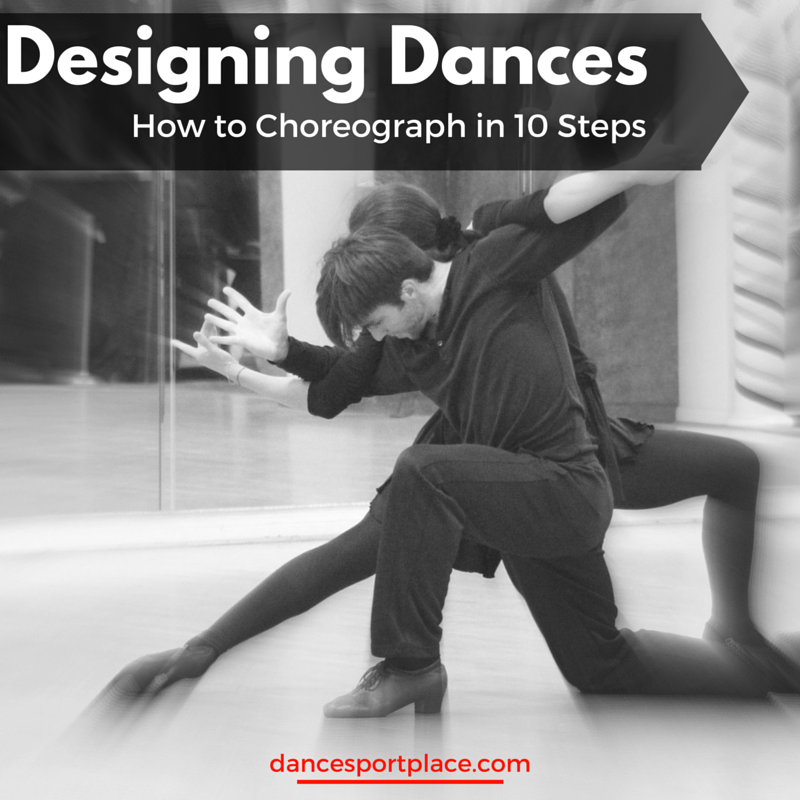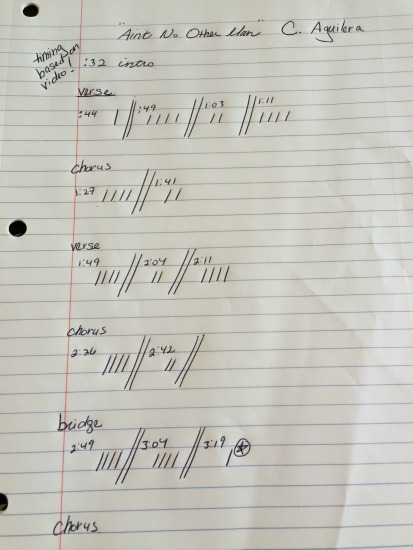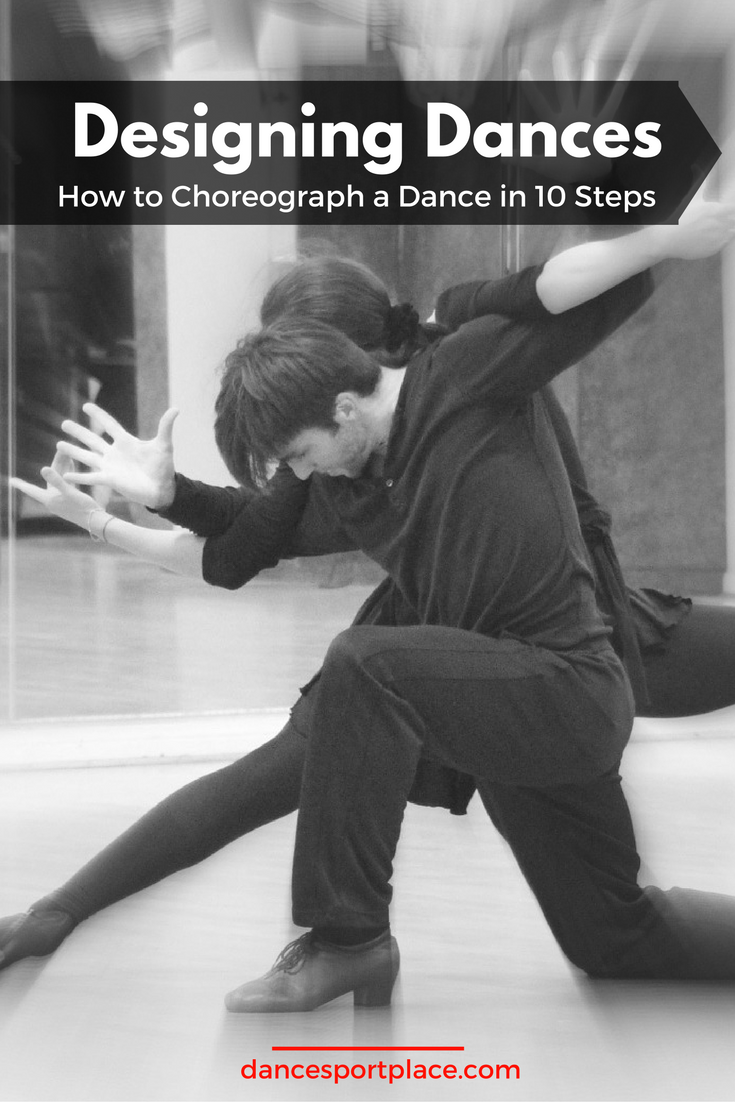What kind of choreographer are you? How do you choreograph a dance?
Give me a melody and an empty floor and I’ll paint a masterpiece with music notes and bodies!
or…
I can knock out routines easy enough, but it’s not more of a chore than a choice.
or this…
Why can’t routines be more like line dances?! Choreo 24 counts and repeat it for 2 minutes—that would be a dream!
Whether you enjoy it or not, doing choreography is part of the job when you’re a dancer or dance instructor.

I always loved to choreograph and my first pieces (this was my pre-ballroom days) were choreographed when I was in 6th grade, in my bedroom.
My muse? Duran Duran. With my ballet background, my favorite songs to choreograph to were “Save a Prayer” and “The Chauffeur”. (OMgosh, that is soooo embarrassing to see in writing! 😂) Moving on…..
Although I enjoy designing dances, unfortunately, I’m a very S-L-O-W choreographer. I enjoy the process and come up with decent ideas, but it takes me a while to hammer it all out. As an adequate choreographer, I can get the job done, but it’s nothing like…
The Gifted Ones
Over the years, I had the privilege of working with and interviewing many choreographers. Each has their own unique method in sculpting dances. Some are just dance geniuses and can conjure up a great number with little more than a thought, a beat and 20 minutes. Others take a more analytical approach, but emerge with equally impressive results.
I’m in awe (and slightly envious!) of those dancers who can step onto a lesson and knock out an amazing piece in 45 minutes. One of those great choreographers I’ve had the privilege to work with is Jean-Marc Genereux.
He deftly combines musicality, theme, with the individual skills of the dancers and cranks out choreographic “hits” in record time.
Derek Hough also comes to mind as one of the rising preeminent choreographers of our time. I’ve never worked with him personally to see his method first-hand, but knocking out jaw-dropping, smile-inducing, tear-jerkingly brilliant Emmy-winning choreography week after week on DWTS speaks to his impressive productivity!
And of course, there are many exceptional choreographers in our ballroom world, but then there’s…
The Rest of Us
For those of us who AREN’T genius dance composers, though, we can still improve our skills and become BETTER and even FASTER choreographers.
And remember, at either end, EVERY choreographer at some point will hit “dancer’s block”, just like a writer does. When the creative juices have run dry and all you can think about is either rehashing the same old stuff or deleting the music from your iPhone.
When you hit THAT wall, here are 10 steps to help you get back on course:
1. Inspiration
What you see, hear, feel, touch in everyday life can be inspirational fuel for the choreographer.
A captivating piece of music is often a trigger for creativity, but what if you’re handed a piece of music to choreograph and you hate it?
You’ve got to get creative about being creative.
- An experience you’ve had or someone told you
- A story plot you’ve read
- An exploration of an emotion
- A fantastical story from your imagination
- Use the time and place the music was made, as the backdrop for you theme
Check out what World Champion and Emmy-nominated choreographer Louis van Amstel has to say about creating dances in our interview together (start at 3:40)
2. Choose your music and edit
For most choreographers, it starts here. The music to inspire the theme, mood, patterns, highs and lows in your piece.
If you’ve got a 3 minute routine to do and the song is 5 minutes, start EDITING.
When you edit, by deciding which parts you want to keep and which transitions you want to connect will help to get you more familiar with the structure of how your piece will develop.
If your piece doesn’t need to be edited, start listening to it…A LOT.
And NOT at the studio. Listen to it while you’re driving, as background music at home, while resting in a relaxed state with your eyes closed.
This is not the time to worry about what you’ll choreograph, it’s time to help you FEEL the qualities in the music and get comfortable with it.
3. Choose a theme
Once you’re familiar with the song, it’s time to start honing your overall vision. Is this a story piece? Are you telling the exact story of the lyrics, or are you using them to tell your own descriptive story?
Or is this an abstract piece? Are you being lead more by the feeling of the music than the words? It can still be helpful to find a storyline, even in an abstract piece.
4. Map out your timing
This is for all you logical types out there. This process helps me to choreograph a dance faster for those time when I don’t have the luxury of daydreaming about my dance for a long time.
It helps me focus and see the music ALL AT ONE TIME, on paper. Kinda like a “choreography timing sketch”.
I’ve attached a pic of a timing sketch for “Ain’t No Other Man”, by Christina Aguilera. *NOTE: the timing cues are paired to the video, not the track itself. (So, you can watch the video right now and count it out with my notes 🙂
Here’s a quick overview of how I do it (let’s get NERDY!):

Notice, I hash mark (tally mark) each measure (8 counts) and the breaks with a double line. The timing cues reference the start of the measure in each set. Sometimes I give myself notated cues on the sketch, like squiggles for sounds that remind me of rotation, or ascending arrows when the sound is escalating, or descending for when it gets quiet, etc. I made one cue here (circled star at 3:19), because this is a highlight moment and I’d probably want to do something special there.
Here’s the video…count along with my notes!
5. Envision the dance
Step back from the minutia of the particular steps and musical breakdown and envision the dance as a WHOLE.
- Does it move around the floor?
- Cover both depth and length?
- Do the transitions make sense?
- Are you mixing the kinds or movements you’re doing? (traveling movements, turning movements, poses, lifts, fast/slow parts)
These details can also be hashed out once you’re working on the piece, but taking an overview as you’re in the process of making the dance is helpful.
6. Account for your dancers’ skills
Imagine being an interior designer, with the best carpenters on hand, unlimited budget and carte blanche to do whatever you want. It would make designing a room a whole lot easier!
The hard part is when you have a limited budget and have to account for the taste of your clients.
It’s the same for dancing. Heck, you could choreograph the electric slide for Baryshnikov and it would be phenomenal. But, it’s a much harder task to choreograph a dance that fits the dancers you are working with.
This goes both ways. If you have dancers with limited skills, don’t OVER-CHOREOGRAPH. They will look BETTER with simpler choreography. Difficult movements will just magnify where they are lacking.
When you have dancers with exceptional skills, create towards that. Derek Hough does this brilliantly, highlighting his partner’s unique gifts.
Check out this example of Derek and his Dancing with the Stars partner, gymnast Shawn Johnson:
7. Choose the steps
Refer back to step 5—are you mixing up the kinds of moments you’re doing?
Do you have mandatory movements that need to be used? (ie syllabus patterns)
Refer to step 6. What special skills do your dancers have that should be highlighted? What kinds of movements suit them best?
8. Try it in real life
Many a brilliant piece of choreography has turned out to be a dud once it moved from just me dancing in my kitchen to adding 2 or more REAL LIVE people.
Or there have been times when that super-cool-lightening-fast-footwork section had to be tossed out. Turned out humans can’t actually move as fast in real life as in my MIND.
And don’t forget if you’re working with newer dancers, that you may have overestimated their ability. Be flexible here and don’t be afraid to SIMPLIFY, if necessary.
9. Check your theme with your choreography
Does this theme make sense? Can the audience relate to it?
No matter whether you’re “selling” a dance, a song, or a life insurance policy, for people to engage, they must be moved emotionally.
Does your dance make them smile, excited, heart-warmed???
If your dance is to be memorable, you’ve got to impact the HEART.
Think you need world class dancers to touch your audience? Nope.
Check out this lady. Her dance makes us smiley and heart-warmed. Will you remember it? Probably.
Will you remember it more than that cookie cutter waltz solo you whipped up for last year’s showcase? Probably.
Each dance you create doesn’t have to be a masterpiece, but at least design it with the intent to touch the heart of the dancer. When the dancer is moved, the audience will be, too.
10. There’s no shame in recycling!
On closer inspection of some of the top dancesport couples, you’ll find recycling happens, especially when partners change. After all, if a dancer has a “trademark” move or group, it only makes sense to repurpose it. Of course, in the case of new dancers, elemental groups are recycled all the time. This isn’t “cheating”, it’s smart and effective.
Do you recycle you own choreography groups? If so, you’re in good company, because illustrious dancers do, too.
Even Disney animators recycle! The first Disney film was “Snow White” and as you’ll see in this clip, they’ve been recycling dance sequences ever since!
And why not? After all,
- if it LOOKS GOOD,
- if it’s a SIGNATURE MOVE of that particular dancer, and
- if it’s CLASSIC, why reinvent the wheel?
HOWEVER, we’re not down with stealing OPC (other people’s choreography). Taking inspiration is one thing, but flat out copying is a no-no.
BONUS TIP:
When you choreograph a dance for formations or groups, you add a whole new dimension to the creative process.
It’s hard enough to envision where one couple will go, face, move, and the connect it seamlessly to the music, let alone 5 or more couples.
The amount of “moving parts” can feel overwhelming!
One simple trick (from my brilliant hubby, Erik) is to map it out visually. You know how football coaches have Xs and Os in a playbook? It works for dance coaches, too!
Block out your choreography on paper with Os for each couple. Draw out a diagram for each time the formation moves to a new configuration. This not only helps you as the choreographer, but also can help your couples “see” your vision faster.
Taking it one step further, before drawing it out, I personally like to use pennies (or poker chips! 😊) and experiment with moving them before I draw it out.
Dive Deeper into Designing Dances
Want to know more about the creative process? I highly recommended reading: “The Creative Habit” by Twyla Tharp, legendary ballet choreographer. Ms. Tharp pulls back the curtain on her methodology, with great tips (and encouragement) for dancers and creatives in any field.
Now, I want to hear from you, Dancer! I’ve come along way from dancing to Duran Duran in my bedroom, but I’m always looking to get better.
What’s your method for designing dances? How do you get through creative blocks? What’s your choreography methodology?
Share your thoughts in the comments below!

- Write your Dance: Improve your dancing through journaling - November 12, 2019
- The Difference Between Oversway and Throwaway: Ballroom Video Preview - June 8, 2018
- Principles of Movement: Ballroom Basics Video - September 21, 2016





Even though I dance so well, what I lack is the skill of a choreographer, a skill to teach. Thanks for these tips!
Just like dancing, choreography takes practice! Happy to hear some of these tips were helpful to you, Emily.
i’m no dancer, my sister is. but i thought those awesome dance moves must look just as awesome in animations, as i’m aiming to be an animator. but taking straightly from the real choreo would be stealing? so I just went up searching for ways of choreographing annddd i came upon this article. it helps me, but in different ways possible. thank you so, so much for these helpful article.
I’m glad you found the article helpful! If you’re using someone else’s choreography in a completely different medium (such as animation), rather than dancing, you should still ask for permission and credit the choreographer. However, since you’re working in a different field, I’m sure many choreographers would be happy to see their creation brought to life in a new way.
I never realized how complicated it is to choreograph a dance. You even broke down the beat of the song and marked it out in pen. It might be a good idea to take a class where I can learn a routine first. Then I can see if I have the ability to continue on.
Hi Callie Marie. Thanks for your feedback. Yes, definitely start taking classes first! Making up your own dances is fun and you don’t necessarily need to have a lot of previous experience, but it certainly helps. When you know more, it’s like having more colors on your palette to paint with. Good luck with your dancing!
I would love for my husband and I to do a surprise dance for our daughters sweet 16. He is very hesitant! He’s very “old school Mexican dad” that would rather stand back and watch. But I would love to have a memorable and fun moment for her. We love old school oldies or old school westcoast rap. I’ve been looking online for different dance moves to nave it easy for him, but the seem to complicated.
Thanks for visiting us and your comment. I’m sure your daughter would be thrilled to see you and your husband sharing a dance together for her special day. At DanceSport Place, we specialize in competitive dancesport, but I’m sure you can find some good ideas on YouTube that even your husband might be up for. Check out some slow salsa, nightclub two-step, or single time swing for beginners. Good luck and have a wonderful time at your daughter’s party!
I like that you mentioned the importance of selecting a theme when choreographing a dance. My uncle is planning on creating a film and needs to hire someone who can help with choreography. Perhaps it would be best for him to hire a dance film director to assist him.
Hello Stefan. The best person for the job would be a choreographer in the dance style your uncle is portraying in the film. Once the choreographer has the theme and concept from your uncle, he/she will be able to create something that fits his vision perfectly.
Thank you for the tips! I passed RAD’s inter-found ballet exam couple yrs ago, and am looking to choreo a solo to audition for entrance to an acting degree in China. Given my short height and lack of expertise, I found your tenth tip pretty reassuring…haha 😉 gna fail tho…
With your ballet experience, Sayz, you’ll have all the fundamental tools needed to create a great audience piece! Now, just add in your own style and personality. Use these 10 choreography tips to help you and you’ll do fine. Good luck!